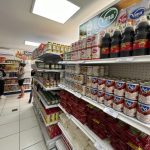The increase in prices surprised again to the upside, Well, on Saturday the National Administrative Department of Statistics (Dane) delivered the inflation report for February, and according to the entity, in the second month of the year there was a variation in the Consumer Price Index (CPI) of 1.63% , which led to the annual inflation at a level of 8.01%.
(Annual inflation in Colombia was above 8%).
This is the highest annual data recorded in a February in 20 yearssince in February 2002 it was 8.06%, and the highest peak since August 2016, when inflation reached 8.1%.
According to the entity, among the items that had a greater weight in the inflation of the month are food, with an increase of 3.26% and a contribution of 0.59 percentage points (pps) to the variation of 1.63% for the month; followed by accommodation, water, electricity and gas, with a weight of 0.23 pps, and a growth of 0.71%.
(These are the cities in Colombia with the highest annual inflation).
The line with the largest increase in prices in February, on the other hand, was education (4.48%), which in turn was among the sectors that most boosted the February data, with a contribution of 0.18 pps. This is because in February, according to Dane, information was collected for calendar A education, as well as higher education enrollment, and other school elements.
Thus, annual inflation for some of the main categories reached 23.3% in the case of food, 12.41% in restaurants and hotels; 8.86% in goods for home maintenance and 7.44% for transportation.
According to the director of Dane, Juan Daniel Oviedo, the figure for February was “Almost double than the one traditionally observed in February of the last six years, which is 0.81%”.
Among the factors that generated this increase, the director of the Dane highlighted that the increase in food was above expectations, added to the transmission of indexations in some goods and services. “Since October we see increasingly steep inflation in the annual variation”Oviedo maintained.
(If prices are rising, how to pay basic basket expenses?).
GLOBAL UNCERTAINTY
The international market, and also the local one, have their eyes set on the conflict between Russia and Ukraineand the tension that the war is transmitting to the price of commodities, and its eventual development, could have an impact on inflation in the medium term.
Despite this, Esteban Tamayo, Citi’s chief economist for Colombia, Peru, Central America and the Caribbean, mentioned how the entity expects total annual inflation “to reach its peak with this February data”, and that from there start a slight descent in the months to come.
“Going forward, we would expect inflation to be above 6% until the middle of the year and then drop somewhat more. It should be noted that current global events present risks to the upside, so the adjustment we expect could be delayed in the face of this new shock,” he said.
Juan David Ballén, Director of Analysis and Strategy of the Brokerage House, also reiterated that “the price of oil continues to rise, and more so since the conflict between Ukraine and Russia began, and that is gradually being transmitted to the fuel prices”.
Camilo Pérez, head of economic research at Banco de Bogotá, agreed with this alert, who assured that international prices have been pressured upwards “not only in the case of oil due to the tight supply in the world, but also due to the conflict in Russia and Ukraine, which further exacerbates the prices of energy and raw materials”.
Pérez maintained that in the short term inflation is expected to remain high, but that, by the end of the second quarter, and above all in the second half of the year you could see a reduction, “if the situation in Ukraine improves a little, and oil prices stabilize. The bank’s projection is at 5.5% for the end of the year.
Expectations and rates.
The levels of inflation that the country is experiencing could also permeate medium-term inflation expectations, and there the role of the Issuer and its monetary policy decisions are key.
Ballén also commented that “long-term inflation expectations have been rising, and that is what has influenced the Banco de la República to begin its cycle of interest rate increases.” According to the economist, since the last increase was 100 basis points, the market now expects the Issuer to be more aggressive in the coming months, “and that will help long-term expectations begin to moderate.”
Alejandro Reyes, chief economist at BBVA Research in Colombia, also said that the acceleration in inflation since the end of 2021 and what is anticipated for this first quarter of 2022 “raise the risk of observing a more general transmission to inflationary expectations and that you end up waking up pricing cycles above the Issuer’s goals”.
Finally, Sergio Olarte, chief economist at Scotiabank Colpatria, indicated that “every surprise in terms of inflation affects medium-term expectations. You can already see, for example, in the Banco de la República survey, the expected inflation for the end of 2023 is rising to levels of 3.6%, showing that the ceiling of the Central Bank’s target range is already being touched.
LAURA LUCIA BECERRA ELEJALDE
BRIEFCASE













